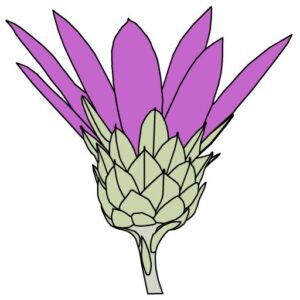Intro
This is a long-time project I have started in 2010, based on a forerunner in 1997. It deals with the distribution, ecology and sociology of a group of thermophytic plants – mostly summer annuals – that seem to undergo changes in that regard. I collect observations of the said species and gather vegetation relevés, so the TherMigs are some sort of cross-over between The Synecologist’s Flora and the Ceplac, with their own questions and priorities.
Main goals of the project are not only to get information on the target species but also to reach at more general insights on the process of spread triggered by climate change and its impact such as invasivity.

Amaranthus viridis, a warmth-requiring plant species recently spreading in Vienna (photography: Rolf Diran 2018).
Thermophytic migrants in the sense of this project are plant species to which the following three assumptions apply:
- They are apparently spreading,
- they are probably warmth requiring,
- their spread is probably furthered by climate change.
In addition, all of the TherMigs are species which I expect to show a clear socio-ecological behaviour. That means that they are or will soon become character species of an existing or newly emerging syntaxon – usually an association – with a clear ecological niche.
Especially at the beginning of the work almost only summer-annual species were dealt with, with special attention to species that seemed particularly promising with regard to the assumptions. Most of the target species therefore a supposed to be or become character species within the Eragrostion s. l. or the Chenopodion muralis (Chenopodietea albi). Other fit into the Sisymbrion or the Polygono-Poetea.
In the meantime, the range of species considered has been expanded, although the initial species still are in the focus. Some of the species added – such as Herniaria glabra – do not fit the assumptions, at least no all of them. But in this case they raise valuable questions similar to “good” project species like the closely related Herniaria hirsuta.
The species in question may be natives or neophytes, in the former case involving internal migration. The words spread and migration are used synonymously here. They cover the following aspects:
- immigration into previously uninhabited areas and sites (especially cooler regions and shadier sites),
- first-time establishment within already colonised areas,
- significant increase in abundance within already colonised areas,
- significant increase in populations with large proportions or even dominance within already colonised areas,
- colonisation of habitats that were previously avoided (niche shift).
These points partly overlap and depend on the definition of what constitutes a non-settled area. It is almost always a question of the spatial scale considered. And the colonisation of new habitats, primarily an ecological aspect, is also always linked to the settlement of new places, which is a spatial aspect. Within the project this does not give rise to any problems.
Species List (Incomplete)
Species marked with ** I haven’t found myself yet, the ones marked with * are extremely rare in my research area. I would be interested in locations of all of these marked species, especially recent findings.
Amaranthaceae (Incl. Chenopodiaceae)
Amaranthus blitum (with at least two subspecies)
Amaranthus crispus*
Amaranthus deflexus
Amaranthus viridis
Atriplex micrantha
Atriplex rosea**
Atriplex tatarica
Chenopodium murale
Chenopodium urbicum*
Chenopodium vulvaria
Dysphania pumilio
Euphorbiaceae
Euphorbia subgen. Chamaesyce: all species, known from my research area are:
Euphorbia chamaesyce**
Euphorbia glyptosperma
Euphorbia humifusa
Euphorbia maculata
Euphorbia nutans**
Euphorbia prostrata
Euphorbia serpens
Other Dicotyledons
Aster squamatus (Symphotrichum squamatum)*
Erigeron bonariensis
Erigeron sumatrensis
Ecballium elaterium*
Herniaria glabra
Herniaria hirsuta
Lepidium didymum
Lepidium squamatum
Polycarpon tetraphyllum
Tribulus terrestris
Xanthium spinosum*
Poaceae
Eleusine: all species, known from my research area are:
Eleusine africana*
Eleusine indica
Eleusine tristachya**
Eragrostis: all annual species except E. minor, known from my research area are:
Eragrostis albensis
Eragrostis cilianensis**
Eragrostis multicaulis
Eragrostis pilosa
Eragrostis virescens
Other Poaceae:
Tragus racemosus
Additional Perennial Species (Sociology Unclear)
Cyperus eragrostis
Cyperus esculentus
Cyperus rotundus
Muhlenbergia mexicana
Panicum virgatum()
Sorghum halepense
